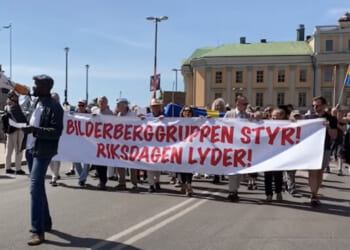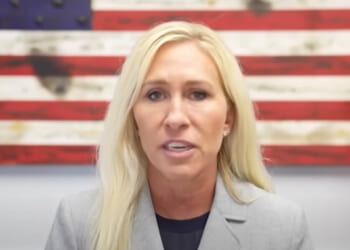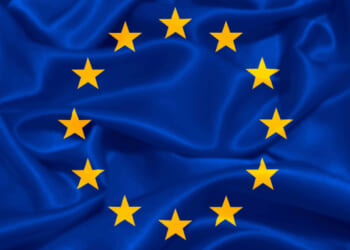By Nick Griffin
Is Donald Trump being kept in the dark as two separate and extraordinarily provocative “Ukrainian” attacks on hugely important Russian targets drag us closer than ever to World War III and nuclear Armageddon?
Click the Link Below to Listen to the Audio of this Article
I put the word “Ukrainian” in quotes, because the sophistication and pinpoint intelligence behind Volodymyr Zelensky’s latest long-range attacks make it all too likely that they were carried out with the help of U.S. intelligence forces.
The question is not so much “did the CIA know and assist” but “did the CIA and other U.S. warmongers provide Kiev with the information, coordinates and expertise with the approval of Donald Trump, or is the commander-in-chief being kept in the dark?”
The first attack was an audacious assassination attempt, during which Ukrainian drones targeted Vladimir Putin’s personal helicopter as the Russian president visited the Kursk region, now firmly back under Russian control after Kiev’s strategically futile but dramatic offensive there collapsed with a terrible loss of men and materiel.
The high-stakes and precise attempt to kill Putin raises questions about external support. Drones capable of striking a moving target like a helicopter require sophisticated real-time intelligence, including satellite imagery, signals intelligence, or human assets on the ground. Ukraine, while increasingly adept at drone warfare, relies heavily on Western aid for advanced technology and intelligence-sharing.
Could Ukraine have pulled this off without U.S. or closely allied assistance? It’s possible but unlikely. NATO has provided Ukraine with billions in military aid, including advanced drones and access to intelligence platforms like satellite imagery and SIGINT or “signals intelligence.”
Reports from 2022 onward confirm that U.S. intelligence has guided Ukrainian operations, from targeting Russian generals to sinking ships like the Moskva. A strike on Putin’s helicopter would almost certainly require precise, real-time data, the kind typically supplied by U.S. or NATO assets.
Regardless of who was really behind the attempt on his life, Putin’s response was swift, with a series of ruthless strikes on key targets in Ukraine. Coming just days before scheduled peace talks in Turkey, it was this onslaught which prompted Trump to say on “Truth Social” that Putin appeared to have “gone absolutely crazy.”
Had the missile blitz on Kiev assets indeed been unprovoked—as Trump appeared to believe—such a comment might have had some justification. But it quickly emerged that the U.S. president was unaware of the drone attempt on the helicopter transporting Putin.
Trump’s later admission that he didn’t know about the Kursk incident can reflect only one of two things: An appalling failure of U.S. intelligence, or a deliberate decision by key elements within the intelligence community to keep the president out of the loop. Either is scandalous.
Significantly, the claim that Trump was deliberately misled was supported by none other than Russian Foreign Minister Sergei Lavrov, who announced that Trump is being “kept in the dark.”
This is certainly plausible. The intelligence community and Pentagon have a history of selective briefings to steer policy. During Trump’s first term, he clashed with advisors such as neocon warmonger John Bolton over interventionist policies. The Kursk incident could be a case where intelligence agencies, working with their Ukrainian counterparts, facilitated the operation but didn’t fully brief Trump, presenting him with a narrative that justifies escalation—like framing Putin as “crazy” for retaliating.
Lavrov’s assertion, echoed across multiple “X” posts, suggests that “bad actors” within the U.S. system are filtering information to manipulate Trump into supporting Ukraine. Trump’s admission that he didn’t know about the drone attack lends credence to Lavrov’s point. If the president isn’t privy to details of operations involving U.S.-supplied intelligence or equipment, it indicates a deliberate effort to limit his oversight and manipulate his decisions.
The second Ukrainian strike, on June 1, was less symbolic, but of enormous strategic importance. Following the attempt to decapitate Russia, it was a very serious attempt to deprive her of a crucial part of her nuclear deterrent.
Ukraine’s SBU intelligence service claims that four airbases in Siberia were hit, adding that “34% of strategic cruise missile carriers at the main airfields of the Russian Federation were hit.” The meticulously planned sabotage attack involved 117 drones, transported in civilian trucks to strike over 2,500 miles behind the front lines.
The assassination attempt may have angered Putin personally, but the destruction of—if Ukraine’s notoriously dishonest intelligence and propaganda outlets are to be believed—a third of Russia’s strategic cruise missile bombers is a serious threat to the security of the entire nation.
The destruction of Tupolev Tu-22M heavy bombers would significantly degrade Russia’s nuclear arsenal. The claimed financial cost of $7 billion is not as significant as the impact on the country’s ability to wage a nuclear war.
If similar damage was to be repeated against other sections of Moscow’s strategic arsenal, it would not be a huge surprise if Putin and his advisers concluded that Kiev’s forces are being used as proxies for a NATO campaign to grind down Russia’s defensive capabilities.
The only purpose of such attrition would be to get to the point where NATO could launch the all-out nuclear first strike that has long been part of its Cold War military doctrine.
At which point the Russians could conclude that nuclear war is inevitable, and that it would be better not to wait until further degradation attacks, but to launch a pre-emptive blitz of their own. Cue, the Four Horsemen of the Apocalypse!
Within hours of the attack, which brought this horror closer than ever, NewsNation, a sister network of Washington, D.C. daily The Hill, confirmed that an administration official told Tanya Noury of NewsNation that Trump was also not given a heads-up about the attack on the airfields.
Once again, we come to a crucial “either/or.” Either U.S. intelligence agencies didn’t know what their Ukrainian puppets were planning, or they did (and almost certainly helped them) but saw fit to keep Trump in the dark.
So, either the Zelensky regime is now a dangerously loose cannon, or the effort of the neocons, Military-Industrial Complex lobbyists and the perpetually Russophobic “Deep State” of the United Kingdom to drag the United States into all-out war with Russia has reached a new level of deadly urgency. To support that claim, former British MP Andrew Bridgen posted, “These attacks are directed by NATO advisors and probably carried out by NATO contractors.”
But why?
Bridgen says:
The cabal who run the world are determined to push Russia into a war with NATO to gain access to the $73 trillion of known Russian natural resources.
Interestingly, both attacks were launched just before direct peace talks in Turkey. It seems like every time Trump goes to talk peace with Putin, something like this always happens. Is it a coincidence, or is the Deep State sabotaging peace?
Nick Griffin is a British nationalist commentator and writer. He was chairman of the British National Party (BNP) from 1999 to 2014, and a Member of the European Parliament for North West England from 2009 to 2014. Since then, Griffin has remained active in British politics despite being vilified for criticizing rampant immigration into the United Kingdom. Contact: t.me/NickGriffin.
(function() {
var zergnet = document.createElement(‘script’);
zergnet.type=”text/javascript”; zergnet.async = true;
zergnet.src = (document.location.protocol == “https:” ? “https:” : “http:”) + ‘//www.zergnet.com/zerg.js?id=88892’;
var znscr = document.getElementsByTagName(‘script’)[0];
znscr.parentNode.insertBefore(zergnet, znscr);
})();

























